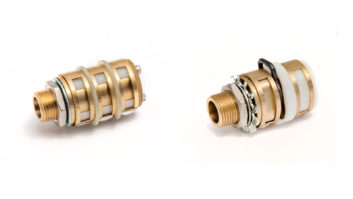
The Drawmer A2D2 DMS-3 uses the same clocking mechanism featured in the M-Clock Plus.
Drawmer has released an upgrade to its digital line with the DMS-5 M-Clock Plus and a new companion piece, the A2D2 DMS-3 A/D converter. The A2D2 is AES Grade-1, meaning that the internal clock has a drift of no more than ±1 PPM, providing a stable frequency source with minimum induced jitter. Clocking is paramount to proper operation of any A/D or D/A unit, and Drawmer uses the same clocking mechanism featured in its M-Clock Plus in the A2D2. Three word clock outputs on BNC connectors are provided for word clock distribution, as well as an external word clock input to reference to a house distribution system, such as the M-Clock Plus.
The Feature Presentation
Two balanced XLR analog inputs are located on the back of the A2D2, both using Burr-Brown analog input circuitry. Two input level modes are available: Calibrated and Variable. In Calibrated mode, two recessed, 24-turn pots allow precision adjustments for input levels in fixed installations where immediate adjustment is not necessary. In Variable mode, two additional potentiometers with external knobs are provided for left/right variable-input control — these being much more accessible when the operating engineer needs quick access to the input levels. Both input modes accept incoming signals from -2 dBU to +28 dBU. Factory calibration places 0 dBFs at -18 dBU.
Two digital output sections are also located on the back of the unit: an AES/EBU XLR, S/PDIF coaxial on RCA, and a TOSlink optical connection on both digital outputs; all outputs are active at all times. This is a great feature for doing remote recording or outside broadcast — multiple recorders with different formats can all be tracked simultaneously. Sample rates are selectable on the front panel between 44.1 and 192 kHz for each output. For example, a 192kHz recording to your DAW could be taking place while sending a 48kHz signal to your video camera. Backups can be recorded with identical sample rates, if desired. Word length is selectable at 16- or 24-bit for each output. The dual-output, selectable sample rate feature is a well-implemented idea. A great-looking, accurate 24-bar LED bar meter rounds out the brushed-aluminum front faceplate. One downside on the front plate: The black lettering against the silver faceplate along with the extremely bright LEDs made both units difficult to read in low light situations.
A2D2 In the Studio
I used the units on a tracking session recording a series of saxophones: baritone, alto, tenor and soprano. I love saxophones as test subjects: They’re rich in harmonic overtones, which can be diminished or augmented through mic placement, and they bring out the best or worst of digital recording systems. I used an AKG C451B to record the various instruments. Taking the line output of a Digidesign C|24 mic pre and multing it to the input of a Digidesign 192 I/O interface and the A2D2, I could track the two A/Ds simultaneously. I chose 88.2kHz/24-bit as my median sample rate for this test. On every horn, on every track, the A2D2 would shine in the instruments’ upper and lower registers. The low end on the baritone was more realistic than what was represented by the other converter, having a greater sense of power (lower harmonics were more accurately recorded and reproduced, and the percussion of the instruments’ air output could be felt and heard on playback), whereas the upper end of the soprano was produced in like fashion: open with more of the surrounding room being represented and realistic. The upper harmonics were more accurately recorded and reproduced, heightening the sense of actually standing next to the instrument.
In the midrange of the instruments, the two converters were virtually identical. Clocking was performed from the 192 I/O for one session, with the M-Clock Plus clocking a virtually identical session.
I performed a similar test with acoustic guitar and female vocals, this time using a Joemeek VC6Q British Channel as the front end. The results from the A2D2 were similar, with a greater degree of accuracy in the lower harmonics with the percussion separating the instruments in the lower end of the frequency spectrum, and air and realism on the top. When A/B’ing the two sessions, there was little that could be ascertained from the different clock sources. The results were unchanged. Even though no dramatic differences were noted, however, the M-Clock Plus has many features that can easily make it a permanent part of your installation.
M-Bop to the M-Clock
The M-Clock Plus offers unique features in the world of clocking. The bread-and-butter characteristics include an AES Grade-1 clock with 10 buffered word clock outputs on BNC connectors for ease of distribution in a large digital system (two outputs are on the front panel), with a selectable generator between 44.1 and 192 kHz. It can also be referenced to an external word clock generator or incoming AES/EBU signals. A blue display indicates your clock frequency, plus ±PPM or ± percent — handy if you happen to be performing pull-ups or pull-downs. A truly unique feature of the M-Clock Plus is the dual sample rate conversion. Both converters have simultaneous S/PDIF, TOSlink or AES inputs and outputs, which allow not only format conversion, but also sample rate conversion at the same time, with all outgoing signals reclocked to the selected master clock frequency. Sixteen- and 24-bit word lengths are selectable, with automatic dithering applied to any signal that is slated for possible truncation.
I used the SRC feature with a 24-bit/96kHz session that was mixed in Pro Tools, sent out of the AES/EBU digital outputs of a Lynx Aurora 8 interface to the M-Plus, where the signal was converted to 16-bit/44.1kHz and recorded to an Alesis MasterLink. Clocking for the Pro Tools session was accomplished internally from the Aurora. The signal was then reclocked to 44.1 kHz and dither added for the 16-bit reduction via the M-Plus. The MasterLink simply clocked off the incoming AES/EBU data stream as it has no external clock inputs available. As a comparison, I bounced the mix internally using the Bounce-to-Disk feature in Pro Tools, with the POWr dither as the last plug-in on the master output fader, bouncing at 16-bit/44.1kHz. The M-Plus did a fine job of SRC, sounding more like the original mix than the internal bounce. In both bounced and SRC’d files, I noticed a slight, edgy sibilance in the vocal “esses” and a decrease of depth and space in the reverb tails, as would be expected when using this process. These were not unusable bounces, by any means; they simply differed from the original 24/96 files, with the unaltered originals sounding better, as they should.
Digital Conclusions
Drawmer has created a couple of easy solutions for the challenges of the digital recording engineer. With the A2D2, a fine-sounding stereo A/D converter includes the ability to output different sample rates simultaneously. The variable input levels make remote recording a little less harrowing, and the three word clock outputs give a smaller studio word clock distribution without adding an additional master clock generator. For larger systems, the M-Clock Plus will be a welcome addition for keeping all clocks dancing to the same drummer, plus the added features of highly functional, dual sample rate converters. If these are the issues you need resolving in your studio, then you’ve found a solution.
Bobby Frasier is an engineer, consultant and guitarist who wishes he was a Beatle.
PRODUCT SUMMARY
COMPANY: DRAWMER (dist. by TransAudio Group)
PRODUCT: A2D2 DMS-3 and M-Clock Plus DMS-5
PRICE: $2,199 each
PROS: A2D2: great sound, outputs different sample rates simultaneously. M-Clock Plus: AES Grade-1 clock, 10 word clock outs
CONS: A2D2: panel hard to read in low light. M-Clock Plus: Dual SRCs regulated to same sample rate as master clock







